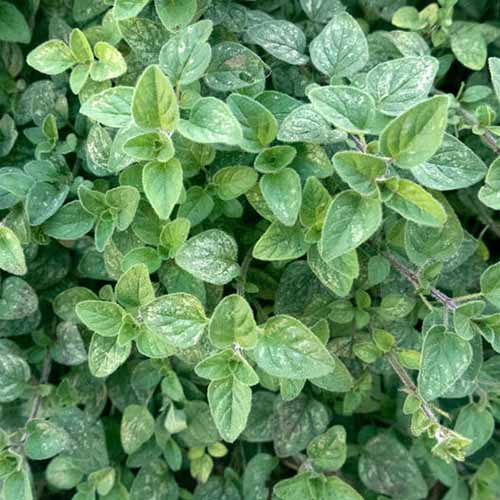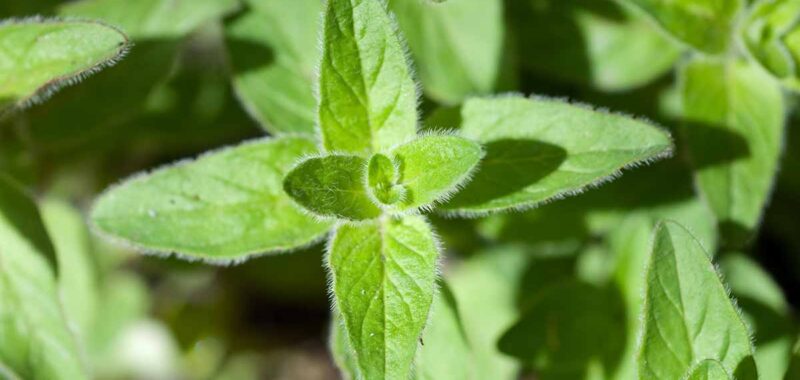Origanum vulgare var. hirtum
Greek oregano is perhaps one of the most familiar of the culinary herbs among cooks in North America.
I use this spicy and flavorful seasoning in just about everything I cook, and therefore it was one of the very first perennials I planted when I started my garden – I wanted a supply on hand at all times!


We link to vendors to help you find relevant products. If you buy from one of our links, we may earn a commission.
Feel the same way? Read on to learn all about growing your own Greek oregano.
There are a number of species and cultivars that are referred to commonly as oregano, coming from different regions and with different flavor profiles.
A subspecies of Origanum vulgare, Greek oregano is a slightly spicy herb with an earthy flavor. Native to dry rocky mountainous regions in the Mediterranean, it is commonly used as a seasoning for pizza, sauces, meats, and salads.
Quick Look
Common name(s): Greek oregano
Plant type: Perennial herb
Hardiness (USDA Zone): 5-10
Native to: Greece, Turkey
Season: Summer
Exposure: Full sun
Soil type: Sandy loam, well draining
Soil pH: 6.5-7.0, slightly acidic to neutral
Time to maturity: 80-200 days
Spacing: 12 inches
Planting depth: 1/8 inch (seeds), depth of container (transplants)
Mature size: 2 feet wide x 2 feet high
Water Needs: Low
Taxonomy
Order: Lamiales
Family: Lamiaceae
Genus: Origanum
Species: vulgare
Variety: hirtum
This perennial herb is hardy from USDA Zones 5 to 10. It grows about two feet tall and wide, with soft hairy leaves. White fragrant flowers bloom from midsummer to fall, attracting bees and butterflies.
A vigorous grower, this plant spreads naturally via underground runners – so well, in fact, that it can even be used as a ground cover!
Learn more about growing culinary herbs as a ground cover here.
Greek oregano grows wild on mountainous slopes of Greece and Turkey.
It is also commonly referred to in the Mediterranean as “wild marjoram,” though it should not be confused with Origanum majorana, which is a different species in the same genus, that has a milder and sweeter flavor.
Technically, the flavorful culinary herb we call Greek oregano isn’t wild marjoram itself, but a much more flavorful hybrid subspecies.
Use of Greek oregano dates back to ancient Greece, where it was said that it was created by the love goddess Aphrodite, who grew it in her garden atop Mount Olympus as a symbol of joy. It was commonly planted around homes to ward off evil spirits.


Packed with the antimicrobial phenols known as thymol and carvacrol, this herb has also been used to treat a variety of ailments since ancient Greek and Roman times, such as indigestion, toothaches, and coughs.
It wasn’t until the 1940s that it became popular in the United States, when it was brought back by US soldiers who had been fighting in Italy during World War II.
Of course, the most significant use of this aromatic herb is as a culinary spice. A common ingredient in Italian and Greek cuisine, it is used in everything from pizza and pasta sauce to meats, soups, and vegetable dishes.
Propagation
Plants can be propagated from seed, transplants, root cuttings, or by division.


While all of these methods may be successful, my preference is to take root cuttings from healthy plants. This way you know you are getting an offspring of similar quality and flavor to the parent.
And if you happen to have a friend with an established plant this method is completely free!
Check out our guide to growing oregano for detailed instructions on propagation.
How to Grow
This hardy Mediterranean native is fairly tolerant of nutritionally poor soils, strong winds, and hot, dry conditions.


Let’s explore how to give Greek oregano the best start and care through the growing season:
Spacing
If planting more than one, space plants at least a foot apart, or eight to 10 inches apart if growing as ground cover.
Use bark, shredded leaves, or other natural material to mulch around the base of plants.
Light
Greek oregano needs full sun—at least six to eight hours per day. This is essential for the plant to develop its full aromatic potential.
If you grow oregano in partial shade, it will survive, but the flavor and oil content will be diminished.
In hot southern climates, a little afternoon shade can be beneficial to reduce stress during heatwaves, but overall, more light equals more flavor.
Soil
Oregano doesn’t need rich soil—in fact, the flavor can become bland in overly fertile ground. Aim for well-draining, moderately fertile to poor soil with a pH between 6.5 and 7.0.
If your soil tends to hold moisture, amend it with compost or grit to increase drainage. Avoid overly acidic or soggy areas, which can quickly lead to root rot.
Temperature and Humidity
This herb thrives in warm, dry environments. Ideal growing temperatures fall between 60 to 80°F.
It can handle the occasional cold spell and even frost once established.
However, in humid climates, good air circulation is key to avoiding mildew and other moisture-related issues.
Water
Provide about an inch of water a week to new plants. Once established, let the soil dry out completely between waterings and water only when the soil feels dry.
Make sure not to overwater. This drought tolerant plant is accustomed to dry climates and does not enjoy being in waterlogged soil.
Fertilizer
Skip the heavy feeding. Oregano doesn’t need much in the way of fertilizer.
If your soil is especially depleted, you can add a light dose of balanced fertilizer or compost once in early spring as growth resumes.
Excess nitrogen leads to lush growth but at the expense of essential oil concentration—meaning a milder flavor.
Container Growing
Since these plants don’t need constant moisture, they are an easy choice to grow in containers.


Choose a pot with good drainage and use a sandy or gritty potting mix. Clay pots are ideal because they allow the soil to dry out more quickly.
Keep containers in a sunny spot, water only when the top inch of soil dries out, and avoid over-fertilizing.
Overwintering
In Zones 7 and above, Greek oregano can usually overwinter in the ground with minimal protection.
In colder areas (Zones 5-6), mulch with a thick layer of straw or shredded leaves in late fall to protect the roots.
If you’re growing in containers, move them to a sheltered location like an unheated garage or cold frame.
Cut back growth in late fall to reduce stress on the plant through winter
Where to Buy
If you have a friend or neighbor with an established plant, ask whether they would mind if you take a few cuttings.
Otherwise, this popular perennial can be found at most nurseries in season, and from online retailers as well.


Greek Oregano
Eden Brothers sells packets of seeds in a variety of sizes.
Or to get a jump start, you can find live plants in packs of three available for purchase at Burpee.
Maintenance
These tough herbs don’t need much in the way of maintenance.


You can trim regularly to encourage bushy growth rather than sprawling. Since the leaves have the best flavor just before they flower, pinching back the plant as buds develop will prolong the tastiest harvest, as well as encouraging bushy growth.
Of course, there are benefits to letting the flowers do their thing, as the bees and butterflies will attest to.
You can also cut back the dead branches after the first frost in fall or in early spring.


Mulch heavily in fall around the base of plants to protect them through winter, and watch them return with vigor the following spring!
Pests and Disease
Oregano is a hardy, disease resistant plant. It is actually a useful companion plant for most vegetables as the aromatic flowers attract pollinators and other beneficial insects. It is also said to repel cabbage moths.
While there aren’t too many pests and diseases to be concerned about, plants can still suffer damage from aphids, leafminers, and spider mites, as well as fungal pathogens that may cause root rot. And as a member of the mint family, Lamiaceae, they can occasionally suffer from mint rust.
Be sure to ensure proper spacing around plants and avoid overwatering to prevent rot. Minor pest infestations can often be taken care of with a strong spray from the hose, or by pinching back affected leaves.
Specifics on how to identify and treat oregano pests and diseases can be found in our guide.
Harvesting
Leaves can be harvested any time after plants are at least six inches tall, starting around 45 days after planting.
The best time to harvest is in mid to late morning, after the dew has evaporated, and when the essential oil content in the foliage is at its highest.


You can harvest as needed throughout the season, or pick a large amount all at once for drying.
To harvest small quantities for immediate use, choose a stem at least six inches long, and cut just before a set of leaf nodes about two thirds of the way down. Be sure to leave about a third of the leaves intact on each stem that you cut.
To harvest more significant quantities, you can cut back the entire plant to within a few inches of the ground, leaving at least two to three inches of stem and leaves in place to allow the plant to recover.


Cut each stem about a quarter inch above a set of leaf nodes. This will cause the plant to branch out and become bushier as it recovers and puts on new growth.
Harvest liberally for drying, as leaves will shrink down to about a third of their fresh size as they dry.
Preserving
This herb is easy to dry and store for use throughout the year.
If you have a food dehydrator, set it on the lowest setting, between 95 and 115°F, and check periodically. Leaves should be fully dry in around four hours. Leaves are ready when they can be crushed easily in your hand.


You can also air dry leaves by tying stems in bundles and hanging them upside down inside a paper bag with a few holes punched in it to allow for airflow. Hang the bags in a dry sheltered location.
The bag helps shield leaves from dust and light exposure while also reducing the risk of mold, and as the leaves dry, they will begin to fall from the stems.
For quick drying, you can also use the oven. Separate the leaves from the stems and lay them in a single layer on a baking sheet lined with parchment paper.
Bake in a 200°F oven, leaving the door slightly ajar for air circulation. Stir every five minutes until leaves are dry enough to crumble, about 10 to 15 minutes total, then turn off the heat and leave in the oven until completely cool.
The dried herb can be stored whole, crumbled, or powdered in an airtight container in a dark cupboard. I recommend storing the leaves whole, as they will retain the strongest flavor. They can be crushed or powdered easily right before use.
Find more tips on drying herbs in our guide.
Spice Up Summertime
It is no wonder Greek oregano has been so popular for so long!
Not only is it one of the most flavorful culinary herbs out there, but it is also incredibly hardy and easy to grow. Plant some this season and enjoy your meals seasoned with garden fresh oregano for years to come.


What is your favorite use for this herb? Share your thoughts in the comments section below.
Want to learn more about growing perennial herbs? Check out these articles next for more ideas:



